
AI workflow tools are changing how businesses automate tasks. With features like integration with large language models (LLMs), real-time logs, and error handling, these platforms simplify complex processes. This article reviews ten top-rated tools based on user feedback and performance, helping you choose the best fit.
| Tool | LLM Integration | Key Feature | Pricing (Starting) |
|---|---|---|---|
| Prompts.ai | 35+ LLMs | Visual builder, cost control | $37/month |
| Lindy | Dynamic LLM selection | Natural language automation | Freemium |
| Gumloop | Premium LLMs included | Drag-and-drop workflows | $37/month |
| Vellum.ai | AI agents | Multi-use agent creation | Custom |
| VectorShift | Python SDK | Developer-focused workflows | $25/month |
| Relay.app | 8 LLMs | Plain-English workflows | Freemium |
| n8n | Open-source | Node-based editor | Free/$20 Cloud |
| Activepieces | 200+ integrations | Visual workflow builder | Free plans |
| Windmill | Unknown | Not detailed | Unknown |
| Zapier | AI-enhanced Zaps | Trigger-action workflows | Free/$20/month |
These tools cater to different needs, from non-technical users to developers. Choose based on your team's expertise, integration needs, and budget.
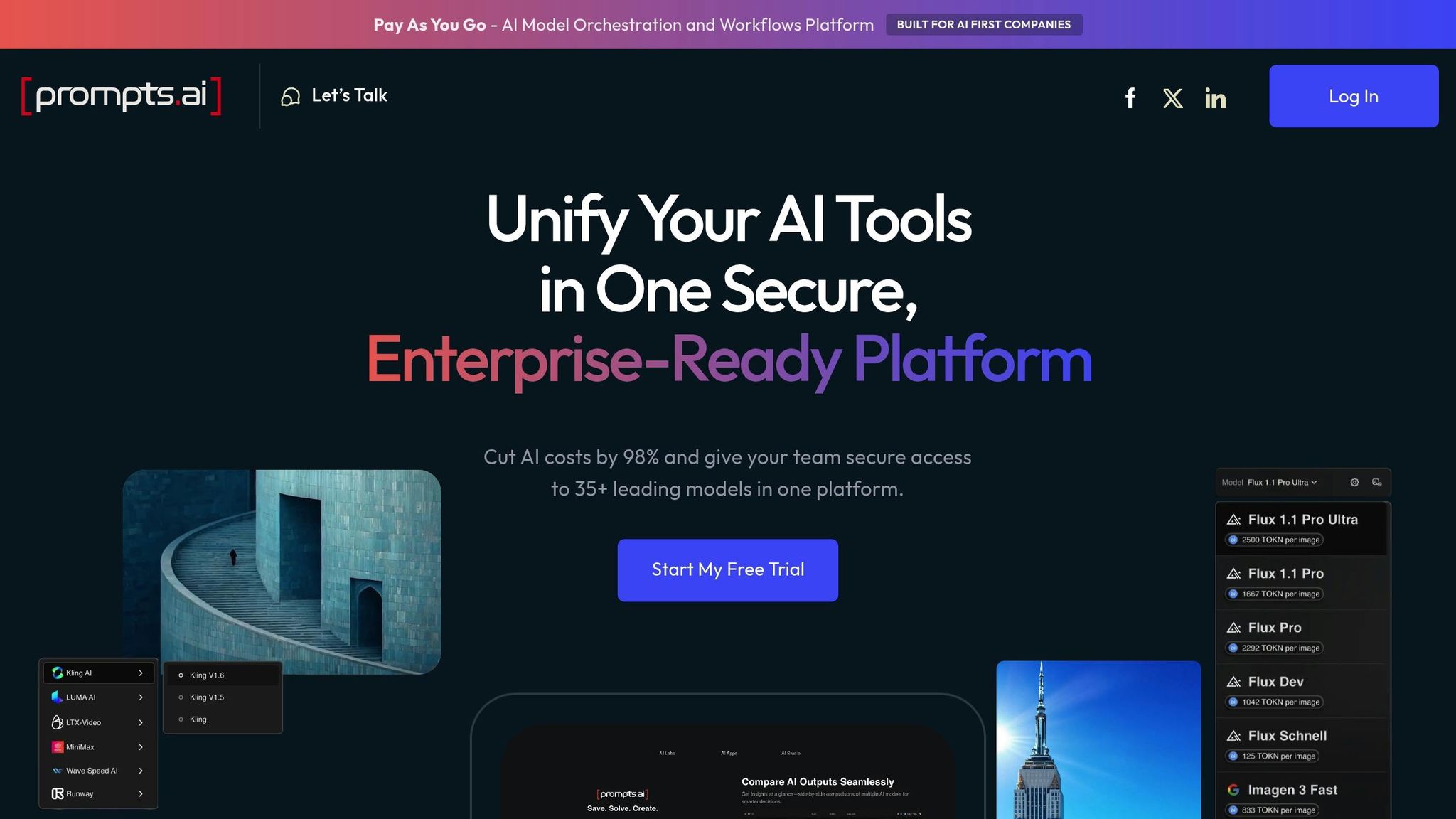
Prompts.ai is a cutting-edge platform designed for enterprise use, combining over 35 leading large language models (LLMs) into one secure and centralized interface. It streamlines the complexities of managing multiple AI tools by offering centralized cost control and governance.
Prompts.ai connects seamlessly with top-tier models like GPT-5, Claude, LLaMA, and Gemini, eliminating the hassle of juggling multiple subscriptions and interfaces. By handling the technical intricacies of LLM integration through secure APIs and native connectors, the platform allows users to switch between models effortlessly within the same workflow. This makes it easy to compare performance side-by-side. Additionally, its prompt engineering tools enable teams to create workflows for text generation, summarization, and decision-making without needing specialized technical knowledge.
Prompts.ai has already gained traction with major companies such as Shopify, Instacart, and Webflow. These examples highlight its dependability in enterprise settings, proving its ability to simplify AI workflow management.
Prompts.ai takes its integrations further with a visual workflow builder that features drag-and-drop functionality. It integrates smoothly with widely-used business tools like Slack, Google Workspace, Microsoft 365, and Salesforce, making it accessible for both technical and non-technical users. Key features include conditional logic, trigger-based actions, and the ability to orchestrate responses based on LLM outputs. For instance, a marketing agency used Prompts.ai to automate social media content creation with GPT-4, cutting manual work by 60% while boosting engagement with AI-optimized posts.
With an impressive user rating of 4.8, Prompts.ai is celebrated for its reliability and user-friendly interface. Users frequently highlight its ability to handle complex workflows with ease, benefiting both enterprise teams and individual creators. Many report quicker project completion times and enhanced creative output. While occasional delays in customer support during peak times are noted, the team is praised for its responsiveness. The platform also prioritizes security with encrypted data transmission, secure API authentication, and compliance with GDPR and CCPA standards.
Prompts.ai is committed to transparent pricing, eliminating hidden fees. Its unified approach, paired with a pay-as-you-go TOKN credit system, allows organizations to reduce AI software costs by up to 98%. A free plan is available, while paid plans start at $37 per month. Tiered options include Core ($99/month), Pro ($119/month), and Elite ($129/month) per member. Each plan offers advanced features and real-time cost optimization. Additionally, its built-in FinOps layer tracks token usage, providing cost monitoring and actionable recommendations to help businesses align AI spending with their goals effectively.
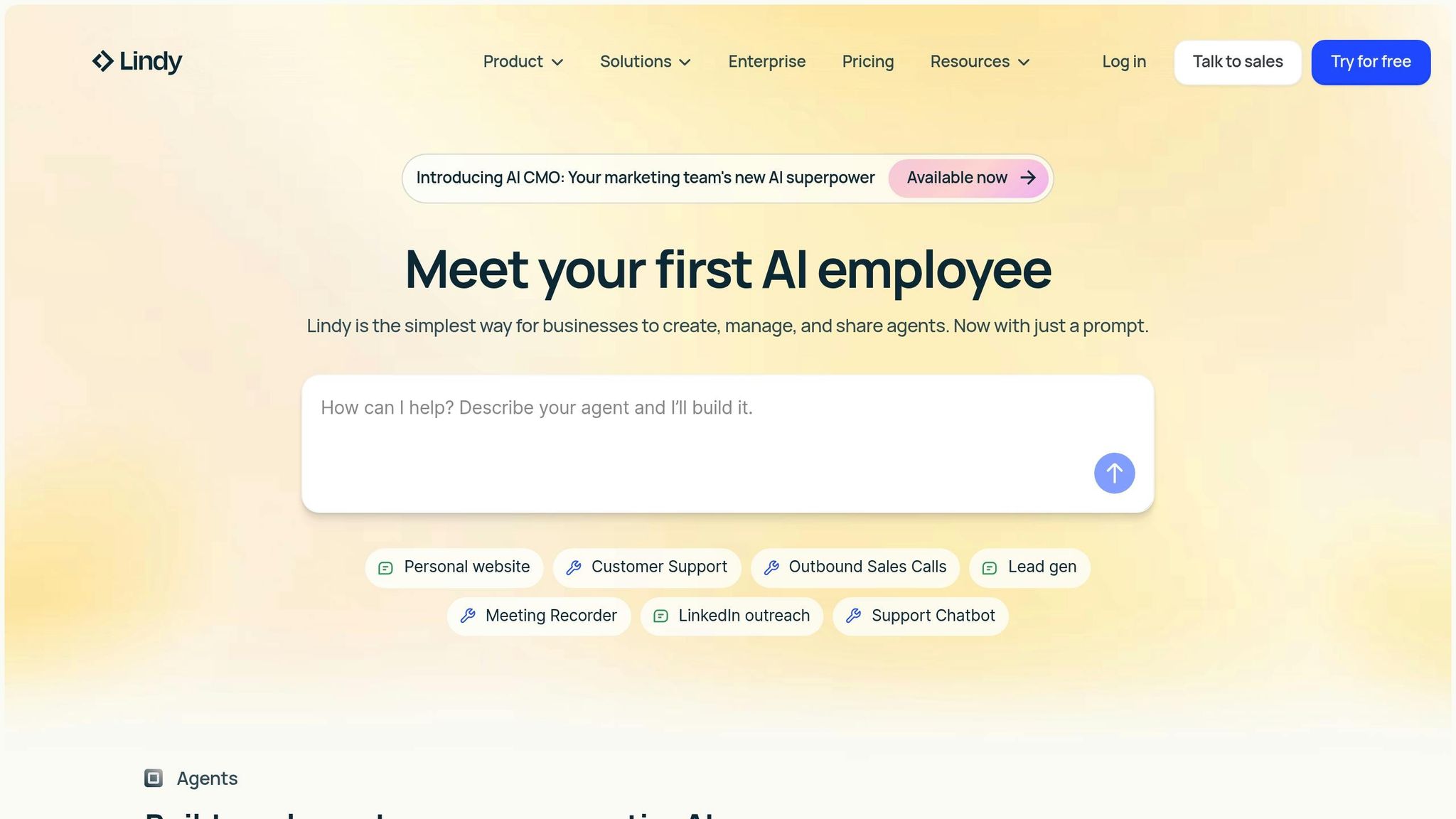
Lindy simplifies multi-step workflows by using an AI-driven, natural language interface. It interprets user instructions through advanced natural language processing, transforming them into automated tasks without requiring complex technical setups.
Lindy integrates seamlessly with large language models, selecting the best model for each task dynamically. Its straightforward, plain-English interface ensures that even sophisticated automation can be utilized across an entire organization with ease.
With its LLM integration, Lindy enables automated decision-making across various systems. It supports intricate, cross-system workflows by using contextual data to execute actions like processing communications, updating records, and retrieving information. This goes beyond simple, trigger-based automation, offering a more comprehensive solution.
Users consistently highlight Lindy’s intuitive, conversational interface, which makes setting up workflows straightforward. It delivers dependable, efficient automation that enhances productivity.
Lindy offers a freemium model alongside usage-based pricing, ensuring clear and scalable cost management.
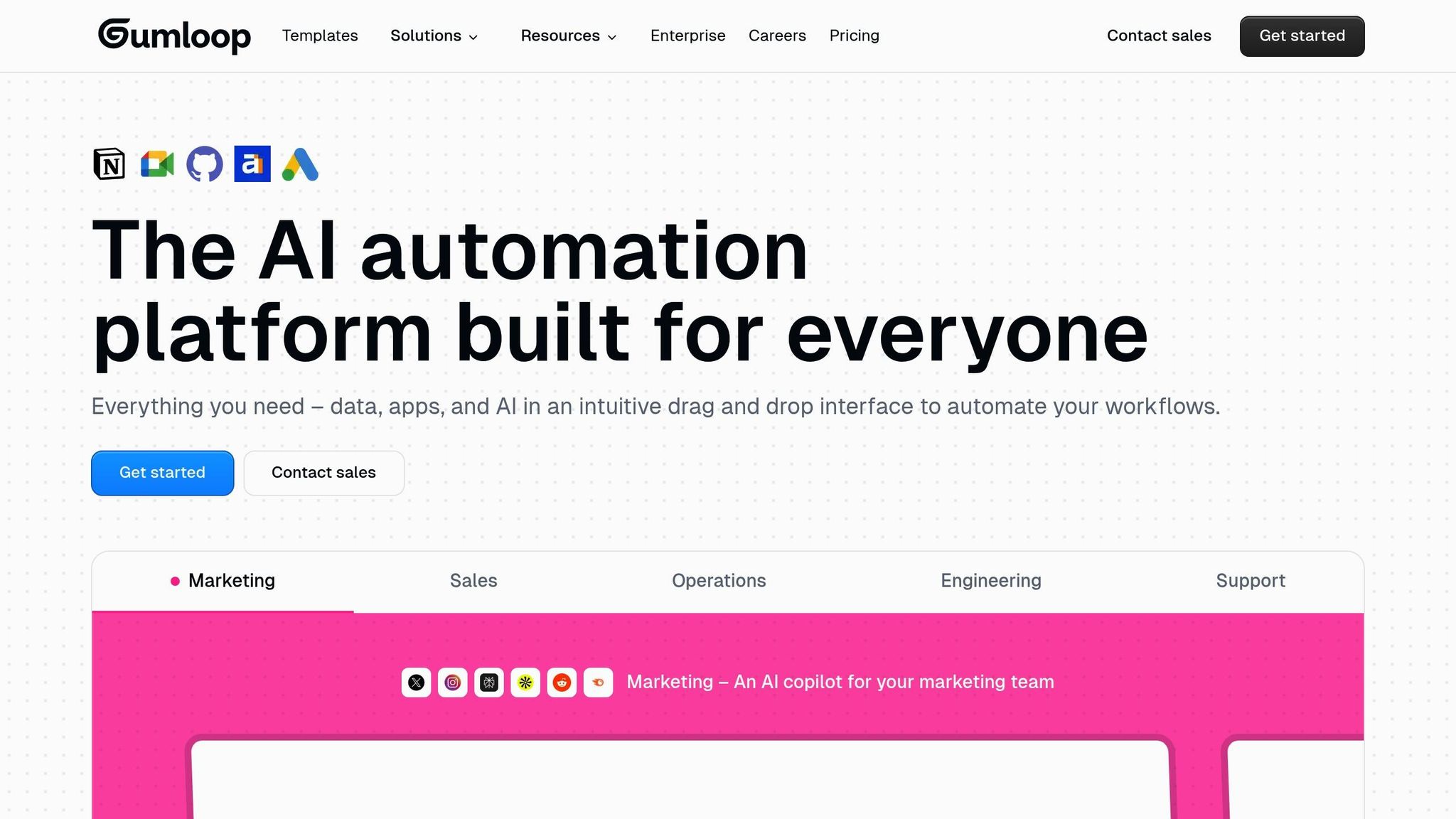
Gumloop is a platform designed to simplify AI workflows for both technical and non-technical users. It’s become a go-to solution for organizations aiming to integrate AI into their operations without unnecessary complexity.
One standout feature of Gumloop is its built-in access to premium LLMs. This eliminates the hassle of managing separate API keys or incurring additional costs, making it easier for users to tap into AI’s full potential. The integration supports the platform’s automation tools, ensuring a smooth and efficient experience.
Gumloop empowers teams to create and implement automated workflows, even if they lack technical expertise. Its visual interface is straightforward, allowing users to design complex processes that connect various systems and applications without needing advanced programming skills.
Gumloop’s impact is evident in the feedback from industry leaders. Fidji Simo, CEO of Instacart, shared:
"Gumloop has been critical in helping all teams at Instacart - including those without technical skills - adopt AI and automate their workflows, which has greatly improved our operational efficiency."
Bryant Chou, Co-Founder of Webflow, also highlighted its value:
"Gumloop wins time back across an org. It puts the tools into the hands of people who understand a task and lets them completely automate it away."
Users frequently praise the platform for its simplicity and clean interface, describing it as “really easy to use.”
Gumloop offers a clear tiered pricing system, catering to a range of users, from individuals to large enterprises. The plans include:
| Plan | Price | Credits/Month | Seats | Key Features |
|---|---|---|---|---|
| Free | $0 | 2,000 | 1 | 1 active trigger |
| Solo | $37 | 10,000+ | 1 | Unlimited triggers, webhooks |
| Team | $244 | 60,000+ | 10 | Unlimited workspaces |
| Enterprise | Custom | Custom | Custom | Advanced security, admin controls |
All plans include premium LLM access without additional API fees, offering excellent value. Both free and paid options are frequently described by users as generous and practical.
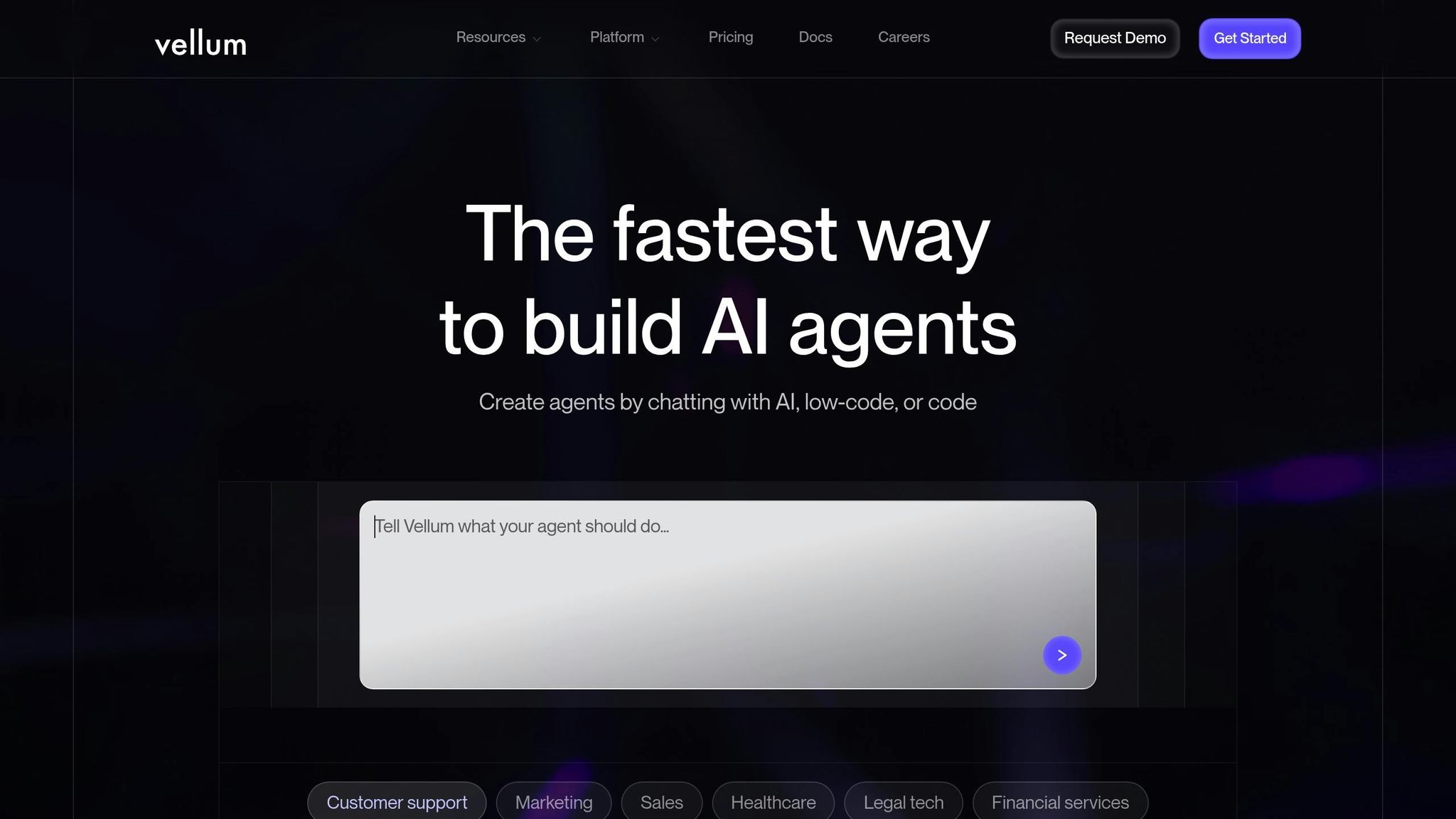
Vellum.ai empowers users of all skill levels to design AI agents, offering multiple approaches to tackle complex workflows.
The platform stands out for its versatile agent creation options. Users can build AI agents by conversing in plain English, working with low-code interfaces, or diving into traditional coding. This flexibility ensures that both technical and non-technical team members can actively participate in automating workflows.
Vellum.ai simplifies development by automatically generating workflow logic, tools, and integrations based on user input. This capability extends to creating specialized AI agents tailored to specific business functions:
This multi-faceted approach cements Vellum.ai as a go-to platform for streamlining AI-driven workflows.
Vellum.ai enhances its workflow capabilities with seamless LLM integration, enabling its AI agents to support a variety of business functions. The platform prioritizes ease of use, eliminating the need for complex technical setups.
Users can deploy agents in multiple ways, such as embedding them directly into applications via SDKs or APIs, sharing them internally with teams, or publishing them with a single click for immediate use. These deployment options ensure that AI agents fit smoothly into existing workflows without disrupting current operations.
Vellum.ai’s advanced features are supported by comprehensive testing and monitoring tools. A sandbox console allows users to test agents during development, identifying potential issues before deployment. Once live, the platform provides visibility into real-world interactions, enabling continuous performance monitoring and refinement.
For enterprises, reliability and security are paramount. Vellum.ai delivers on this with integrated quality checks and tools for managing and sharing agents across teams. Security measures include SOC 2 Type 2 compliance, HIPAA support, VPC options, and on-premises deployment, meeting the rigorous demands of large organizations.
With proactive testing, real-time monitoring, and enterprise-grade security, Vellum.ai offers a dependable solution for organizations aiming to scale AI agent deployment while maintaining high operational standards.
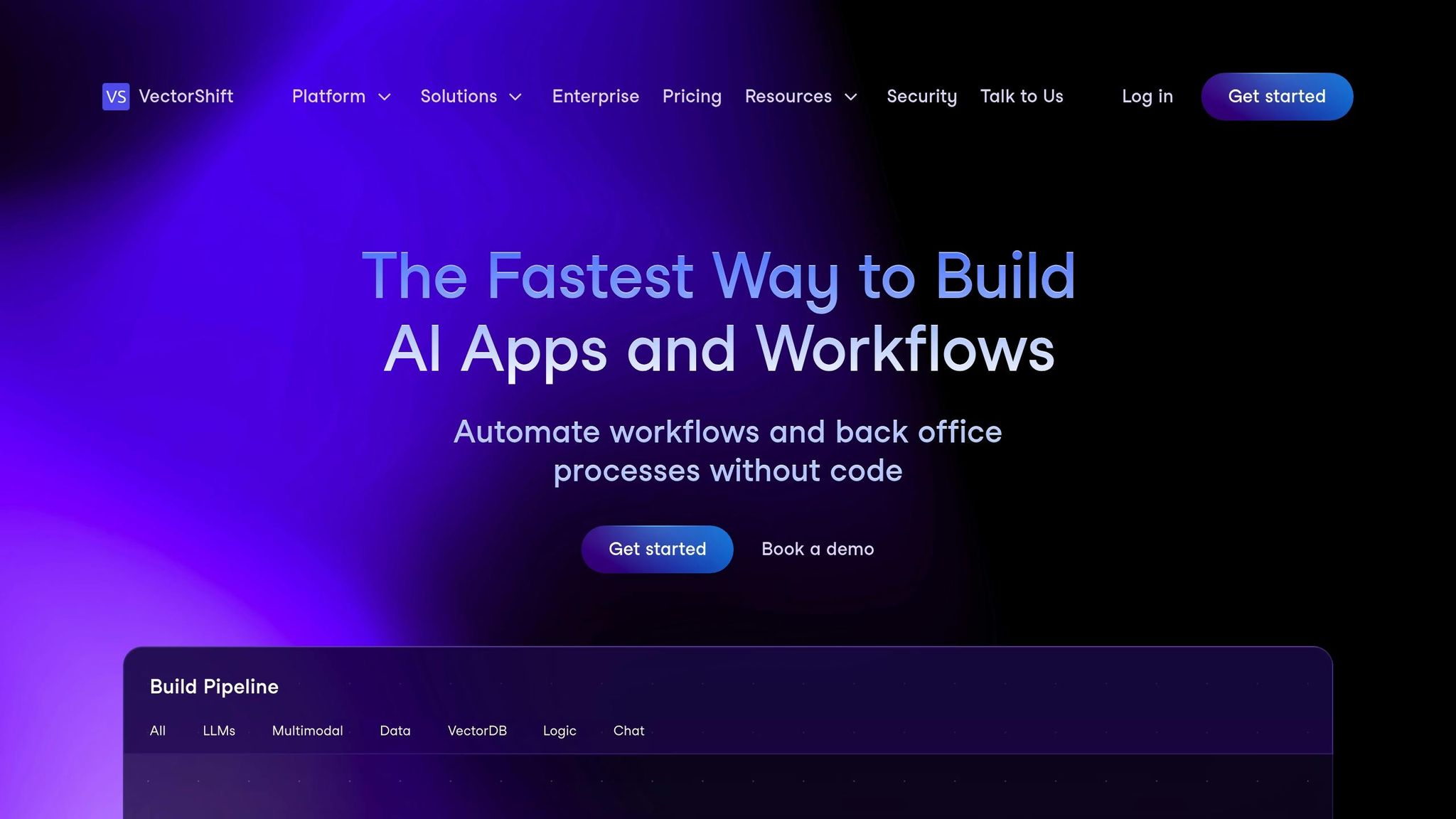
VectorShift stands out in 2025 as a developer-focused platform for AI workflow automation. It offers technical teams powerful tools to manage complex AI processes, combining a robust Python SDK with seamless integration capabilities.
VectorShift enables the creation of advanced, multi-step workflows that go beyond basic task automation. With its drag-and-drop workflow builder and Python SDK, teams can choose between visual design and detailed programmatic control. For instance, it can streamline customer support by routing inquiries through sentiment analysis, crafting responses with custom-trained models, and logging interactions in CRM systems. Another example includes automating document workflows that involve OCR and natural language understanding. These use cases highlight its ability to handle intricate, multi-layered processes efficiently.
The platform supports a wide range of LLMs, including popular commercial options like OpenAI's GPT series, as well as custom machine learning models. Through its Python SDK and API connectors, developers can select the most suitable AI model for each workflow step, ensuring optimal performance at every stage. This flexibility is a key reason developers report a positive experience with the platform.
Developers praise VectorShift for its adaptability and its capacity to manage complex automations effectively. While its advanced features are a major draw for technical users, non-developers often find the platform's learning curve steeper. Industry experts regard VectorShift as a standout solution for developer-centric AI workflow automation, bridging the gap between no-code simplicity and code-based precision for intricate tasks.
VectorShift offers transparent, tiered pricing starting at $25 per month, scaling with usage to accommodate teams of various sizes. This structure ensures flexibility for both small teams and larger enterprises.
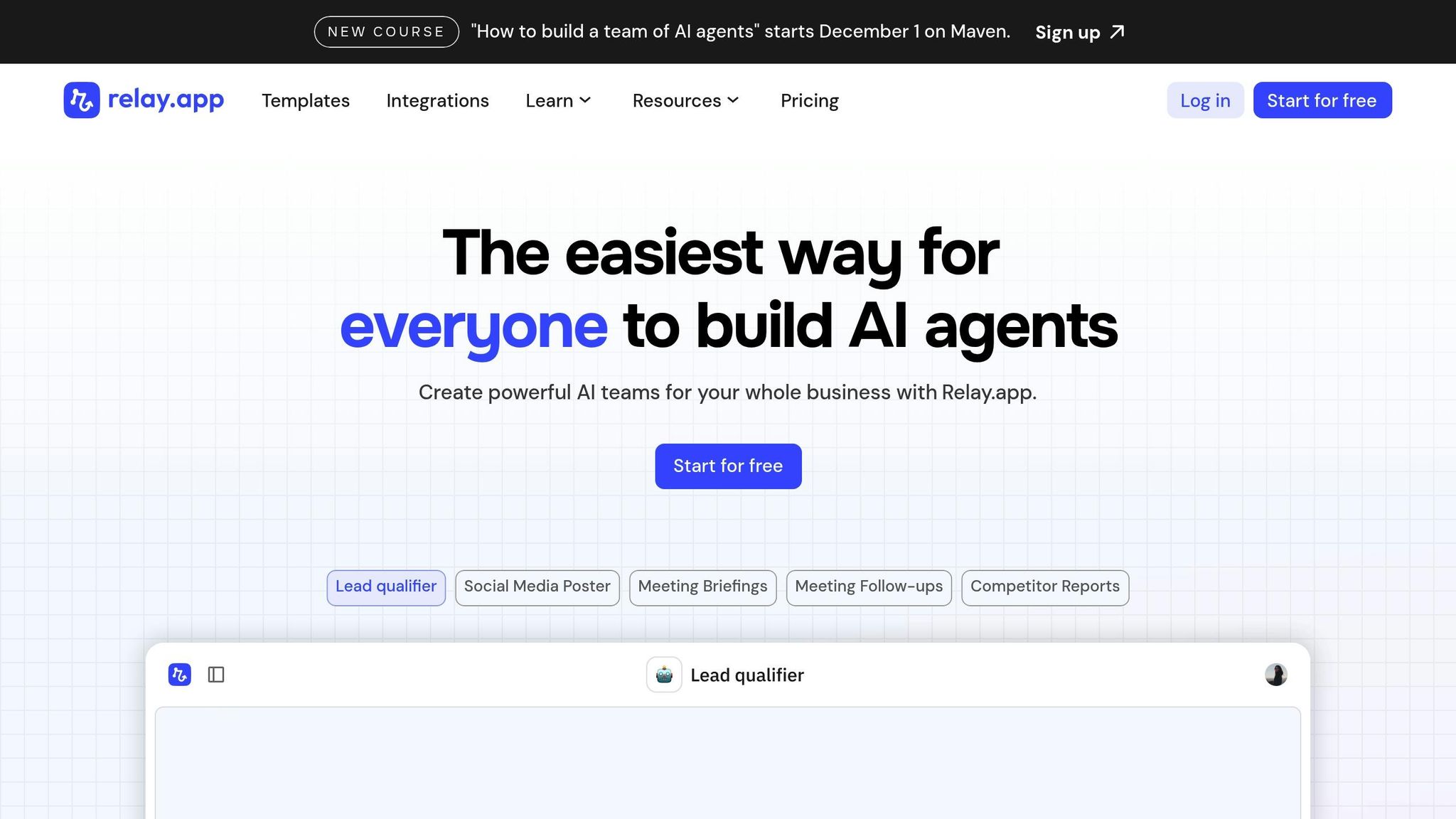
Relay.app simplifies AI workflow automation, making it accessible even to those without technical expertise by turning plain-English task descriptions into automated processes.
Relay.app seamlessly connects with eight leading LLM providers: Anthropic, Google Gemini, Groq, Mistral, OpenAI, Perplexity, Qwen, and xAI. These integrations enable a variety of tasks, including research, data analysis, content summarization, information extraction, decision-making, and writing.
The platform supports a "human in the loop" model, allowing users to incorporate manual approvals or data requests into automated workflows. This ensures oversight while maintaining efficiency.
For example, Lucas Grey showcased this feature by automating their waitlist collection and response process. Using GPT, they created a workflow to analyze responses to waitlist emails, extract key details, and save them directly into a Notion database - eliminating the need for manual data entry.
Relay.app offers a user-friendly drag-and-drop interface, making it simple for anyone to design powerful, AI-driven workflows. This intuitive platform allows teams to combine multiple AI models with traditional workflow steps, creating tailored solutions for various business needs. Manual approvals can also be integrated, ensuring flexibility and control.
Users consistently highlight Relay.app’s straightforward interface and ease of use. Many appreciate how quickly it enables the creation of advanced workflows while providing clear error messages.
"Just ran my first automation workflow with @relay! I wanted to send newsletters from Outlook to Notion, and it was so easy I almost cried - after struggling and giving up with other tools like Make. Huge thanks to @relay for empowering non-tech folks like me!"
- Lucas Grey (@ImLucasGrey, via X)
The "human in the loop" feature is particularly valued in team environments, where it helps organizations balance automation with hands-on control, making Relay.app a trusted tool for AI-enhanced workflow management.
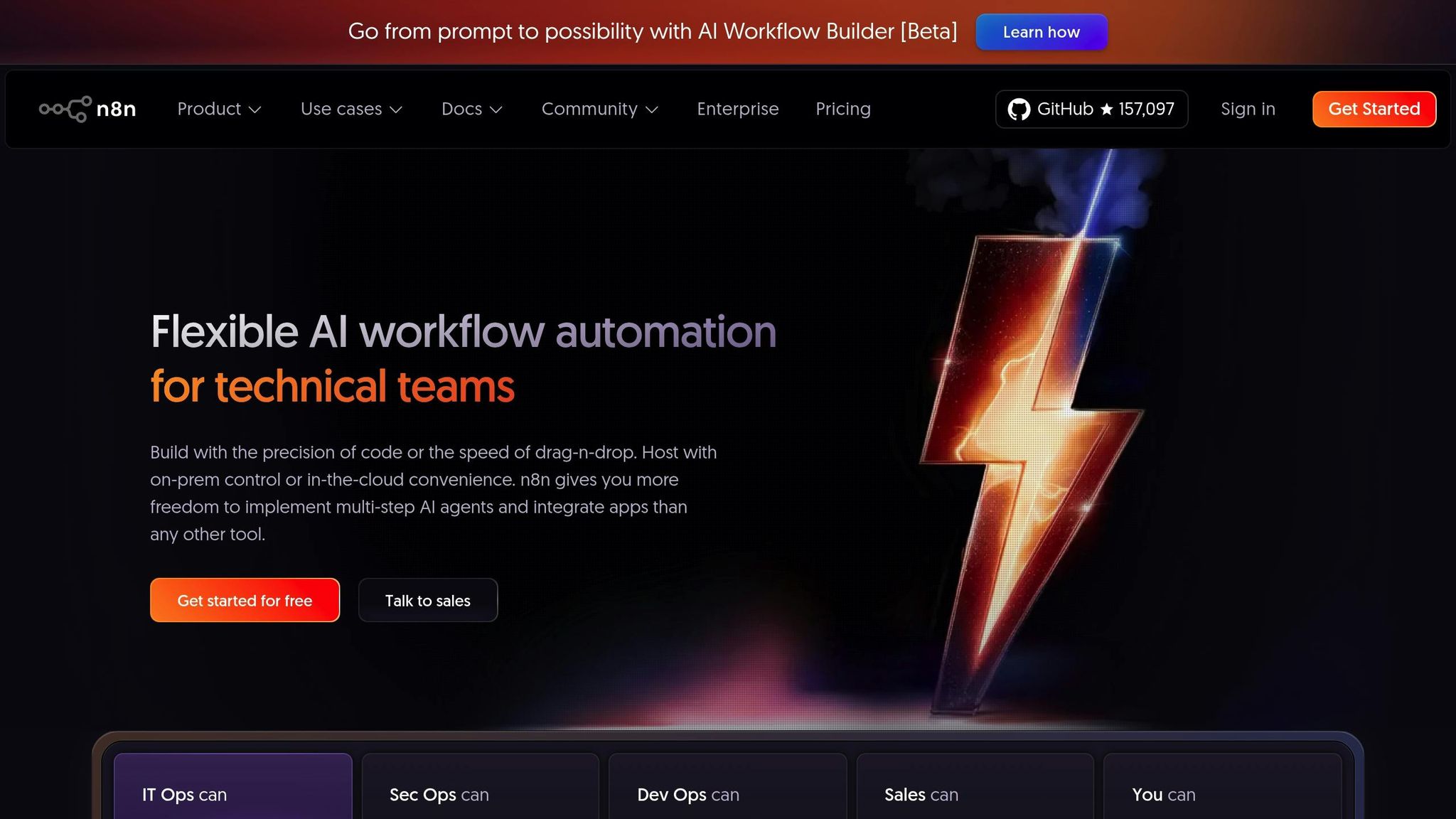
n8n is an open-source platform designed for AI workflow automation. It provides technical teams with a node-based visual editor, extensive API integration options, and a scalable structure, making it a strong choice for creating complex workflows tailored to specific needs.
With n8n's visual, node-based editor, developers can design intricate workflows by connecting pre-built nodes or incorporating custom functions. The platform supports over 400 integrations, allowing smooth interaction with databases, APIs, cloud services, and business tools. Its self-hosted architecture offers full control over data and customization, while features like conditional logic and error handling ensure dependable execution for even the most complex, multi-step processes.
n8n includes built-in support for major LLM providers via dedicated nodes, making it easy for developers to embed AI-driven reasoning into their workflows. Teams can link multiple AI models, handle large datasets with LLMs, and build decision trees based on AI outputs. This versatility opens the door to applications like automated content creation, advanced data processing, and smarter customer service solutions.
Technical teams frequently commend n8n for its flexibility and reliable performance in production settings. It’s particularly valued for its ability to manage high-volume workflows without compromising stability. Features like debugging tools and execution logs receive special recognition, though some users mention that the node-based approach can present a learning curve for those new to this style of automation. The active open-source community further enhances the platform by driving rapid updates and maintaining thorough documentation.
n8n offers a free self-hosted version with unlimited workflows, making it an economical choice for technical teams. Cloud-hosted plans start at $20 per month, while enterprise-level options provide added security and support. As an open-source solution, n8n avoids vendor lock-in and ensures transparency in both functionality and security.
With its emphasis on customization and control, n8n remains a go-to platform for technical teams seeking precise and adaptable automation solutions.

Activepieces delivers AI-powered workflow automation through a user-friendly platform, seamlessly integrating with large language models (LLMs) to simplify and enhance workflow management.
Activepieces features a visual workflow builder that lets users design intricate automation sequences without requiring deep coding expertise. With support for over 200 integrations - including Google Workspace, Microsoft 365, Slack, and Salesforce - the platform enables teams to craft multi-step workflows using a straightforward drag-and-drop interface. These workflows can include conditional logic, data transformations, and automated responses, making it ideal for managing complex tasks like lead qualification, customer onboarding, and content management.
Activepieces connects with leading LLM providers, allowing AI-driven decision-making to become an integral part of workflows. With these integrations, users can perform natural language processing, generate automated content, and conduct intelligent data analysis. This functionality enables workflows that analyze customer feedback, create personalized responses, and process documents with contextual accuracy, streamlining operations across various use cases.
Users frequently commend Activepieces for its intuitive design and dependable performance, even with complex workflows. The platform boasts strong uptime and includes detailed logging and debugging tools to quickly address any issues. Its combination of simplicity and advanced features appeals to both technical and non-technical users, offering enterprise-level reliability while remaining accessible.
Activepieces provides transparent pricing, starting with a free tier that includes basic workflow features and limited executions. Paid plans are competitively priced and scale based on usage, making it suitable for both small teams and larger enterprises. The platform also offers clear insights into usage and costs, enabling businesses to manage their automation budgets effectively as they grow.
With its blend of ease-of-use and advanced AI capabilities, Activepieces stands out as a practical solution for organizations looking to implement intelligent workflow automation without unnecessary complexity.
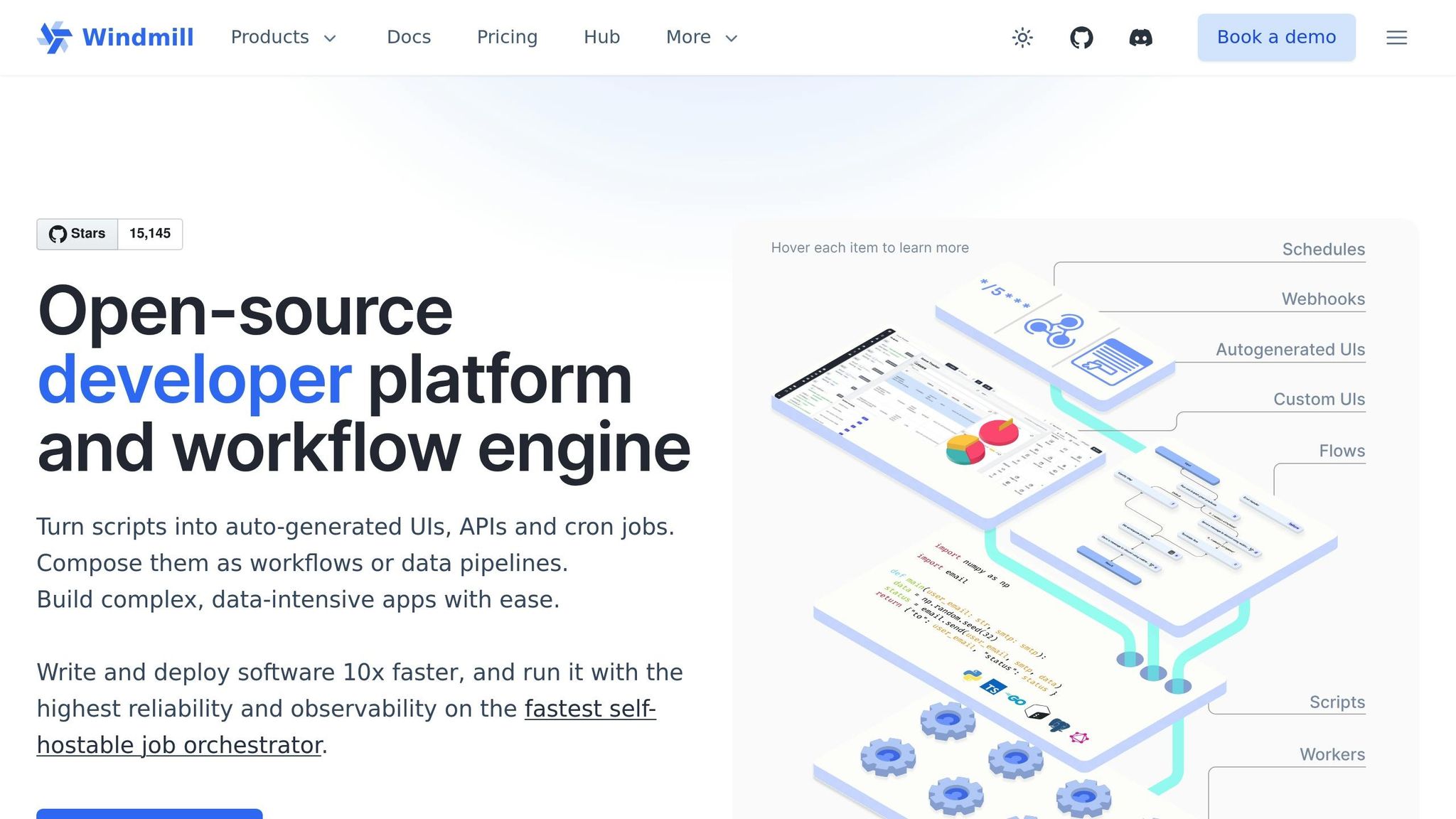
At this time, specific details about Windmill's workflow automation capabilities are not readily available. For accurate and up-to-date information on its features and performance, it's best to refer to the official documentation or seek out reviews from trusted users. Keep an eye out for future updates as more information becomes available.

Zapier has built a strong reputation as a go-to platform for automation, thanks to its intuitive "Zaps."
At the heart of Zapier is its trigger-action model, which supports workflows ranging from straightforward data transfers to intricate, multi-step processes. Features like Path, delay functions, filters, and formatters allow users to create tailored data flows. For those with advanced needs, webhook support and custom code steps provide the flexibility to handle high-volume and complex automation tasks.
Zapier continues to evolve by incorporating advanced AI-driven tools into its already robust platform.
Zapier leverages AI to enhance workflows with capabilities like text generation, data analysis, and processing. This enables users to automate tasks such as creating content, drafting email responses, extracting data, and even performing sentiment analysis - all triggered by specific workflow events.
Zapier is known for its dependable performance, with features like strong uptime, detailed error logs, automatic retries, and task history to simplify troubleshooting.
Users consistently praise the platform for its reliability. Its extensive app ecosystem, which is frequently updated, ensures compatibility with both new and established tools, making it a versatile choice for various integration needs.
Zapier operates on a task-based pricing model, offering a free tier alongside clear, paid plans. Advanced features can be tested without long-term commitment, giving users a chance to explore the platform’s potential.
While businesses with extremely high automation volumes might find the per-task pricing less economical, the platform’s reliability and wide integration options often make it a worthwhile investment.
AI workflow automation has reshaped how businesses handle complex operations, offering tools that simplify processes and integrate cutting-edge AI.
When selecting the right tool, it’s crucial to align features with your specific needs. For companies focused on AI-centric workflows, platforms like Prompts.ai, Vellum.ai, and VectorShift stand out for their seamless integration with large language models and advanced AI capabilities. On the other hand, businesses seeking a broader approach to automation might lean toward established solutions like Zapier or newer options such as Lindy, which combine AI functionality with traditional workflow automation features.
Pricing is another key consideration. Some platforms use task-based pricing, which can become costly as usage scales. Others offer flat-rate subscriptions or open-source options that are more budget-friendly for high-volume operations. Assess your team’s expected automation workload, size, and financial constraints to determine the most suitable pricing model.
Integration capabilities are vital for long-term success. The best tools connect effortlessly with your existing systems, APIs, and data sources. Platforms offering strong webhook support, expansive app marketplaces, and flexible custom coding options often provide the scalability businesses need as they grow.
Additionally, consider the learning curve involved. Some tools are designed with user-friendly interfaces and visual workflow builders, making them accessible to teams with limited technical expertise. Others may demand more advanced skills but deliver greater customization and control.
Performance and reliability are critical factors, especially for complex, business-critical workflows. Tools with proven uptime, robust error-handling mechanisms, and detailed monitoring features tend to earn higher satisfaction ratings from users. These elements become increasingly important as automation becomes integral to daily operations.
Finally, prioritize platforms that demonstrate a commitment to ongoing development. Regular feature updates, active developer communities, and clear plans for incorporating new AI advancements can ensure your chosen tool remains effective as your business evolves.
Whenever possible, take advantage of free trials or pilot programs to test a tool’s compatibility with your needs. The ideal AI workflow automation platform is one that fits your specific use cases, meets your technical and operational requirements, and drives measurable gains in efficiency and productivity.
AI workflow tools bring automation to a new level by utilizing large language models (LLMs) for tasks that demand advanced capabilities like natural language understanding, decision-making, and predictive analysis. These tools simplify processes that would typically require significant manual effort, such as generating content, interpreting data, or managing communication channels.
With the integration of LLMs, these tools can adjust to changing requirements, deliver more precise results, and offer intelligent automation that not only saves time but also minimizes errors.
When choosing an AI workflow tool, it’s important to look for features that ensure smooth integration, the ability to scale with your business, and user-friendly functionality. These qualities help the tool fit seamlessly into your current systems while supporting future growth. Tools with low-code or no-code capabilities are especially valuable, as they allow teams to implement solutions quickly, even without deep technical knowledge.
Equally critical are tools that prioritize security and compliance to protect your data and operations. Look for options that include cost management features to keep expenses under control. Additional functionalities like AI evaluation safeguards, flexible integration options, and rollback controls can significantly boost reliability, making the tool a dependable choice for the long haul.
Intuitive interfaces and visual workflow builders simplify complex processes, making AI workflow tools easier to use for non-technical teams. These features enable users to design and modify workflows without requiring programming knowledge, allowing teams across different departments to seamlessly integrate these tools into their daily operations.
By reducing technical hurdles, these platforms encourage collaboration, improve efficiency, and ensure that even those with limited technical skills can actively engage with and benefit from AI-powered automation. This user-friendly approach plays a crucial role in boosting adoption and unlocking the full potential of AI workflow tools within organizations.


